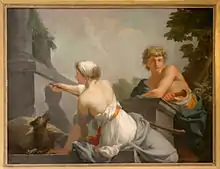Butades
Butades of Sicyon (Ancient Greek: Βουτάδης Boutades), sometimes mistakenly called Dibutades, was the first ancient Greek modeller in clay. The period at which he flourished is unknown, but has been put at about 600 BC. The story is that his daughter, Kora of Sicyon, smitten with love for a youth at Corinth where they lived, drew upon the wall the outline of his shadow, and that upon this outline her father modelled a face of the youth in clay, which he baked along with the clay tiles which it was his trade to make. This model was preserved in Corinth until Lucius Mummius sacked that town. This incident led Butades to ornament the ends of roof-tiles with human faces, a practice which is attested by numerous existing examples.

He is also said to have invented a mixture of clay and ruddle (red ochre), or to have introduced the use of a special kind of red clay.[1]
References
- Pliny the Elder, Natural History, xxxv.151.
External links
- Dibutades' daughter creates drawing, a painting by Jean-Baptiste Regnault
Sources
 This article incorporates text from a publication now in the public domain: Chisholm, Hugh, ed. (1911). "Butades". Encyclopædia Britannica. 4 (11th ed.). Cambridge University Press. p. 877.
This article incorporates text from a publication now in the public domain: Chisholm, Hugh, ed. (1911). "Butades". Encyclopædia Britannica. 4 (11th ed.). Cambridge University Press. p. 877.